Abstract
Even though the ocean is a defining feature on Earth that regulates climate and provides oxygen, food, and jobs, students still have low to moderate marine and ocean literacy knowledge. Ocean literacy is an understanding of the ocean’s influence on people and people’s influence on the ocean. It is an emerging need necessary for ensuring the sustainability of the ocean and its resources. The UN has declared a Decade of Ocean Science for Sustainable Development, and one of the priority research and development areas is ocean literacy. Unfortunately, marine science and ocean literacy topics are poorly represented in school curricula across the world. This study presents the level of marine knowledge in a sample of primary school students before and after different themed non-formal educational interventions and the effect of non-formal educational activities on students’ knowledge. These activities led to significant increase in the knowledge level three weeks after they were performed, indicating the retention of gained information. Performed educational activities and knowledge transfer from graduate level to primary school level significantly increased the level of students’ knowledge, and consequently ocean literacy, and revealed some of the learning misconceptions. Results of this study show that there is a need for an integrated approach to the teaching of Ocean Literacy starting from the early grades by combining teacher’s professional development, strengthening ocean-related topics in school curricula, and promoting non-formal educational activities.
1. Introduction
Even though the ocean is crucial for the health of the planet and human well-being (oxygen production, food, climate regulation, etc.), it is facing numerous anthropogenic threats. Pressures such as pollution, overfishing, and climate change cause biodiversity loss, deoxygenation, acidification, etc., which destabilize marine ecosystems [1,2]. It is essential to understand and to be aware of ocean-related issues in order to protect our planet in general [3]. To conserve and sustainably use marine resources, society needs to be ocean literate and understand the interrelationship between humans and the sea.
The necessity of marine and aquatic education was recognized in the 1970s in [4,5,6,7,8]. In 1996, National Science Education Standards were published in the USA and the lack of marine topics was recognized [9].
To address this gap in school curricula, a diverse group of scientists, educators, and policymakers in the USA collaboratively introduced the concept of ocean literacy (OL) and developed the Ocean Literacy Framework in 2004, which includes a guide with seven OL principles and 45 fundamental concepts. OL is defined as “an understanding of the ocean’s influence on you and your influence on the ocean” [3,10], meaning that “an ocean literate person understands the essential principles about the ocean, can communicate about the ocean in a meaningful way and is able to make informed and responsible decisions regarding the ocean and its resources” [3,10]. Ocean literacy consists of seven principles:
- The Earth has one big ocean with many features;
- The ocean and life in the ocean shape the features of Earth;
- The ocean is a major influence on weather and climate;
- The ocean made Earth habitable;
- The ocean supports a great diversity of life and ecosystems;
- The ocean and humans are inextricably interconnected; and
- The ocean is largely unexplored.
The main goal of ocean literacy is not only to educate but rather to empower individuals to make informed and responsible decisions related to marine resources and ocean sustainability [10]. OL has exceeded the borders of the USA and has been accepted worldwide. Adapting ocean literacy content, concepts, and principles is important for transferring OL content to different regional scales. Region-specific OL frameworks were developed for the Great Lakes—Great Lakes Literacy [11] and recently also for the Mediterranean Sea—Mediterranean Sea Literacy [12].
Moreover, the ocean literacy concept has been recognized by the United Nations (UN) as one of the crucial steps towards the sustainable future of the ocean. Therefore, in order to reverse the decline of ocean health on a global scale, the UN has proclaimed a Decade for Ocean Science for Sustainable Development (2021–2030), where one of the research and development priorities refers to ocean literacy. Moreover, one of the key societal outcomes for the Decade is “an inspiring and engaging ocean where society understands and values the ocean in relation to human wellbeing and sustainable development.” This outcome calls for increased ocean literacy at all levels of society, including education [13]. Additionally, the Decade fully supports the achievement of Sustainable Development Goal (SDG) 14: Conserve and sustainably use the oceans, seas and marine resources for sustainable development, which is one of the 17 SDGs of the UN Agenda 2030 for Sustainable Development [14].
The importance of environmental education has been recognized at the international level since the 1970s with the publication of the UN Belgrade Charter in 1975, followed in 1976 by the launch of the International Environmental Education Programme by UNESCO (United Nations Educational, Scientific and Cultural Organization) and UNEP (United Nations Environment Programme). Around the same time (mid 1970s), the first investigations on students’ knowledge of marine issues were performed in the US, but nearly two decades elapsed before two US commissions (the Pew Commission and the Commission on Ocean Policy, 2003) gave recommendations about the urgent need to expose students to ocean issues. In the same years, a number of investigations into primary and secondary school students’ knowledge and—in some cases—awareness and behavior towards the marine environment, were carried out in the US, in the UK, and in other non-European countries [8,15,16,17,18,19,20,21]. Studies among European students were few [22,23,24,25], and only three regarding the Mediterranean countries [26,27,28]. Interventional studies are still very scarce [24,28]. Although environmental education (later re-named education for sustainable development) is now included in most, if not all, European school curricula [29], ocean literacy, despite its relevant role within the former [30], it has not yet achieved comparably widespread diffusion [31,32].
Interest and positive attitudes towards the sea have been found in a number of studies among primary school pupils, together with a generally low knowledge level and, in some cases, the presence of ocean-related misconceptions [16,18,22,26,27,33,34,35,36,37]. These findings are related, with few exceptions, to the scarcity of ocean-related topics in school curricula of many countries [26,28,32,38], which makes the teaching of ocean literacy optional and not granted to every student. Studies of the primary and secondary school students also showed low and moderate knowledge level, with concern and positive attitudes towards marine environment [21,26,34]. Studies of pre- and in-service teachers showed a moderate level of ocean knowledge [23], and there is similar scarce to moderate knowledge also present among the college and university students from different countries [18,26].
Non-formal education, together with formal and informal education, could increase ocean literacy and contribute to the sustainable future of our ocean. In this paper, we mainly address the knowledge level before and after an educational intervention and assess the effect of non-formal educational activities on students’ knowledge and hypothesize that the students will show an increase in ocean knowledge after participation in educational activities.
2. Materials and Methods
The study was performed in May 2018 in Zadar, Croatia (Figure 1), during the workshops that were held as a part of the celebration event for the European Maritime Day organized by the University of Zadar. Different topics about the marine environment were introduced to three groups of school students: marine biodiversity and marine food web, overfishing, and ocean acidification. Each activity consisted of a theoretical introduction where basic information about the ocean and the abovementioned topics were addressed, followed by a hands-on activity, which individually involved children in different actions (Figure 2). The marine food web workshop included a game in which children students represented a specific marine organism. These “marine organisms” (students) were connected with a piece of rope to each other in respect to their role in the food web. This provided children an insight into the complexity of a food web and the effects of disturbances on the food web and the ecosystems if one or more species disappears from nature. After the game, they needed to draw these interrelationships using their examples of species and determine “who eats whom.” In the overfishing workshop students learned about the impact of different fishing net mesh sizes on the fish in relation to fish size and how this leads to overfishing. They made different sized fish using the modeling paste and needed to pull them through pieces of fishing nets with different mesh sizes. Afterwards, they discussed how modification of the mesh size can alleviate overfishing. In the ocean acidification workshop, students learned about the dissolution of carbonate organisms and their shells under high-acidity conditions. They set up the experiment using water, vinegar, and water–vinegar solution; put carbonate shells of marine organisms into the liquids; and observed the occurring processes, which was followed by a discussion about the occurring processes. These educational activities were performed by the marine science graduate students.
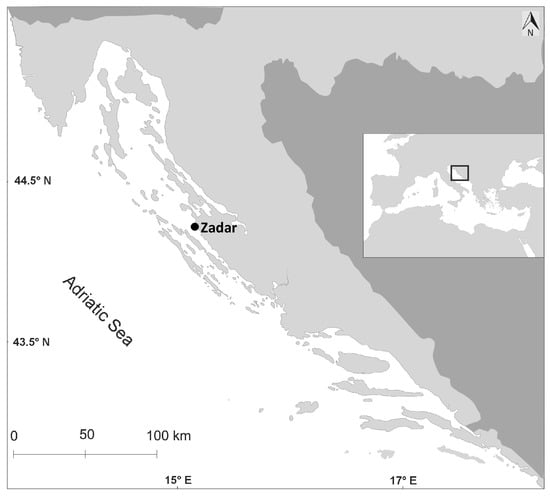
Figure 1.
Sampling location situated in the Adriatic Sea.
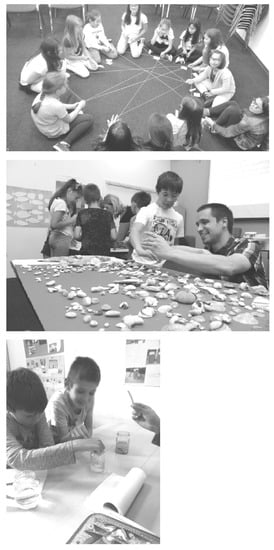
Figure 2.
Students participating in the educational activities.
The questionnaire used in this study was developed based on previous research done by [26,32,39]. The instrument was validated by Rasch analyses performed in previous research [26]. It comprised a section about demographics and non-formal education background, followed by 13 multiple-choice knowledge questions with three distractors and three Likert item opinion questions [40]. The questionnaire was developed in English and then translated into the Croatian language. The questionnaire addressed, with one or more questions, the 7 OL principles (Table 1). The questions referred to the connection between the ocean basins, biodiversity, the role of the ocean in the water cycle and oxygen production, the connection between the ocean and the climate, etc. The paper version of the questionnaire was delivered to the students of the second grade of primary school (8–9 years old). The same questionnaire was administered before and three weeks after the teaching activity. The questionnaire did not collect any personal information. In order to ensure the anonymity and the comparison of the pre- and post-test results, students wrote their code names, which they used again in the recurrent questionnaire. Each correct answer had a value of 1 and incorrect answer a value of 0. A total of 91 questionnaires were collected before the educational activity and 81 (out of those 91 students from the pre-test) three weeks later.

Table 1.
List of OL principles and their alignment with the questions.
The study design compared pre- and post-questionnaire data from the same pupils, before and after the completion of the educational activities. Both the pre- and post-test questions were identical. The feedback was provided after completing the test in the form of the number of correctly answered knowledge questions, and the percentage of change in agreement with the attitude questions.
All data were organized using Excel datasheets and statistical analyses were performed using RStudio 1.2.1335 and R software version 3.6.0 (R Core Team 2019, R Foundation for Statistical Computing, Vienna, Austria, https://www.R-project.org/). In order to compare the pre- and post-education knowledge test scores, the paired samples Wilcoxon test (also known as the Wilcoxon signed-rank test) was used [41,42]. It is a non-parametric alternative to the paired t-test used to compare paired data, which was used because the data were not normally distributed. McNemar’s chi-square test [43] was used to evaluate whether the number of correct responses significantly changed from the pre-test to the post-test for each of the 13 knowledge questions, as well as to evaluate whether the change in attitude significantly increased.
3. Results
Overall, 81 second-grade students participated in both the questionnaire and the educational activities. The girls and the boys were equally engaged (49 and 51%, respectively). Regarding their previous involvement in the environmental activities, 98% (79/81) claimed they participated in the activities organized by their school whereas 81% (66/81) acknowledged having learned the most about the environment from their family members, followed by reading books, browsing the internet, and from friends (58%, 49%, and 49% respectively) (Figure 3).
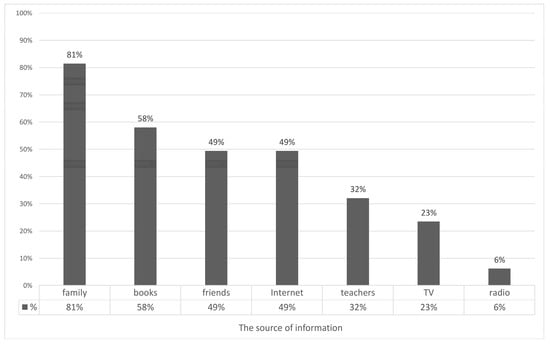
Figure 3.
Main environment and nature information sources.
3.1. Pre-Test
The average score on the knowledge pre-test showed 50.81 ± 16.28% SD (standard deviation) of correct answers. The girls scored an average of 6.58 ± 2.31 SD of correct answers and the boys scored an average 6.63 ± 1.92 SD. Only 19% of the answers given to Question 5 about the origin of rain water were correct, whereas 85.2% of children correctly answered Question 2 about the origin of fish fossils in the mountains (Figure 4). The analysis of students’ attitudes showed that the majority of the students agreed with the statement in Question 14 (81%) and Question 15 (80%) about the ocean having the impact on people no matter where they live and the need for ocean research in order to protect it, whereas only 68% acknowledged the connection between their behavior and the marine environment in Question 16 (Figure 5).
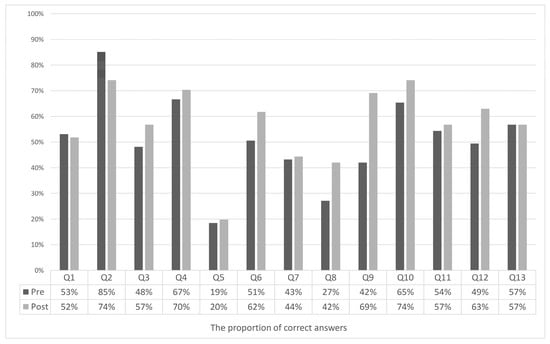
Figure 4.
Bar plot showing the difference in the proportion of correct answers in the pre- and post-intervention knowledge questionnaires. Question (Q).
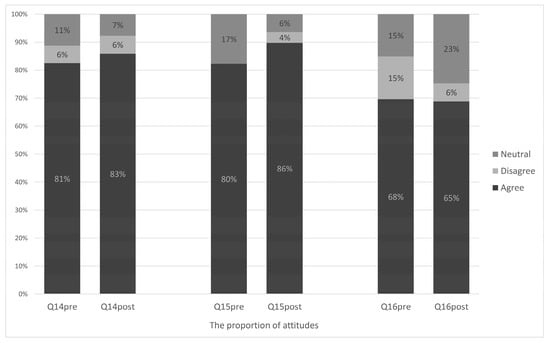
Figure 5.
Stacked bar plot showing the difference in the percentage of change in attitudes in the pre- and post-intervention questionnaires. Question (Q).
3.2. Post-Test
When the same test was given to the participants following the completion of the educational activities, the girls had a slightly higher mean score than the boys (7.52 ± 2.50 SD vs. 7.29 ± 1.95 SD, respectively). The overall mean score increased from 6.6 ± 2.11 SD (50.81 ± 16.28% SD) to 7.41 ± 2.23 SD (56.98 ± 14.58% SD) (Figure 6). The biggest improvement was evident in Questions 8 and 9, whereas Question 2, which had the highest proportion of correct answers on the pre-test (85%), showed a decrease of 11% of correct answers in the post-test (Figure 4). The McNemar test showed that Questions 8 and 9 had a statistically significant (p = 0.025 and p = 0.001, respectively) increase in the number of correct answers after the educational activities. Question 12 also showed an increase that was borderline significant (p = 0.054).
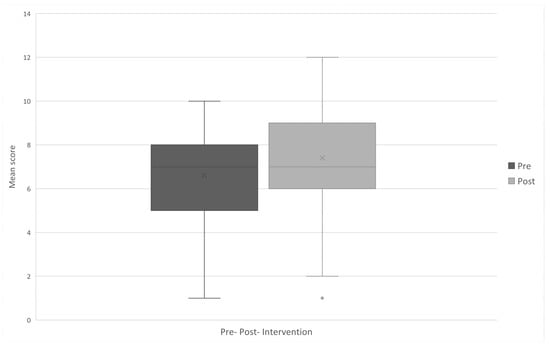
Figure 6.
Boxplot of the difference in the mean score of the knowledge questions in the pre- and post-intervention questionnaires. The box plots show the mean value (x), median (line near the center), the first and third quartile (box), the extreme values whose distance from the box is at most 1.5 times the interquartile range (whiskers), and the remaining outliers (dots).
The Wilcoxon paired samples test was performed on the same 81 students for the knowledge questions and the results show that the overall difference in the number of correct answers between the pre- and post-test was significant (V = 456, p = 0.001), therefore the null hypothesis of no difference in true location shift was rejected, and the alternative hypothesis that the true location shift is less than 0 was accepted (V = 1314, p = 0.9995), indicating that the mean score of the pre-test was significantly lower than the mean score of the post-test.
The student’s attitudes showed no statistically significant change after the educational activities were completed. The increase in agreement with the statements of Q14 (from 81% to 83%) and Q15 (from 80% to 86%) was recorded, but Q16 showed a decrease (from 68% to 65%) in agreement with the statement after the completion of the activities (Figure 5). It is interesting to note the increase in the neutral “I don’t know” answer to Q16 after the educational activities (from 15% to 23%) (Figure 5).
4. Discussion
This study shows moderate knowledge about marine topics in the studied sample of Croatian students, with an average of 50.81% of correct answers. Almost all of the students had participated in some form of environmental activity in the past (98%) and the primary source of information about environmental issues was students’ families. The seemingly low but statistically significant difference in knowledge was recorded, and the results revealed that girls had a slightly higher score compared to boys. Previous studies showed that girls had more pro-environmental behavior and attitudes [44,45], which could also explain the better knowledge in girls. The TIMSS (The Trends in International Mathematics and Science Study) 2015 international survey on fourth graders [46] also found no overall significant difference in science learning by gender in the Croatian sample, but with girls performing better in life sciences and boys in earth sciences. To generalize the results of this study, the sample size should have been larger. However, the presented results show a moderate level of knowledge and this finding is similar to larger studies of marine knowledge levels in students of similar age from different countries and regions such as Italy, Greece, Canada, and Europe [21,22,26,28], but lower than the knowledge level shown by Taiwanese students [47]. The moderate level shown by this study could be attributed to the low presence of ocean science topics in the curricula, as well as the absence of specialized marine-related teacher trainings. The success of environmental education in general depends on teachers’ preparation as well as the quality of the environmental education curriculum [48]. Therefore, ocean literacy education of pre-service and in-service teachers as well as the implementation of ocean literacy in curricula could contribute to generating ocean-literate future generations [49].
Pressures and threats that are present in the marine environment are sometimes hard to understand for the general public [50,51]. Therefore, the involvement of the scientists through scientific outreach and dissemination can be used to improve this understanding and lead to informed and responsible decisions concerning marine ecosystems by the general public, which includes schoolchildren and teachers, but also other stakeholders such as policymakers, local communities, etc. [52].
The results also show the presence of certain knowledge misconceptions, shared by a majority of our sample. Misconceptions have been defined as “ideas that are at variance with accepted views” [53]. They are not just mistakes caused by ignorance. In fact, since the 1970s, they been found to be widespread in science and non-science subjects among students, adults, and even teachers [54,55]. In our sample we found misconceptions related to the origin of atmospheric oxygen and to the connection of water masses. The first one appeared in 1991 in a very cited list of earth science misconceptions [56]; the other was similar to recent results found by other studies [26,28]. In this research, only 27% of the students answered correctly that most of the oxygen originates from the ocean. Additionally, the question with the lowest number of correct answers was the one about the hydrological cycle, where most students answered that rainwater originates from their nearby sea instead of the tropical ocean. In this case, different researchers also evidenced the problems of understanding all the processes and connections involved in the water cycle among high school, university, and teacher students [57,58,59]. Water cycle-related misconceptions in children were also reviewed by [16] and listed within literature-referenced weather misconceptions [60].
There was no significant difference in attitudes after the intervention, but post-intervention results showed a significant increase in students’ knowledge and retention after some weeks had elapsed since the activity, even though the students participated only once in the activity. This indicates that even simple and single-event educational activities could improve marine knowledge. A couple of questions showed a significant increase in the number of correct answers (questions about the origin of oxygen and the blue whale as the biggest animal). One question showed a decrease in the correct answers after the educational activity. This might be because of the different individuals who performed the education. The educational activities were taught by several different students, which might have caused some misinterpretation of certain topics. This implicates the need for consistency and professionalism in the teaching approach.
The results of this study confirm the need for an integrated approach to the teaching of ocean literacy starting with the early grades that combines fostering teachers’ professional development, strengthening ocean-related topics in school curricula, and promoting non-formal educational activities in collaboration with local science communities, aquaria, and science centers. In addition, a few studies that investigated the knowledge of marine science among primary school teachers and student teachers also found limited knowledge among these educators, who were expected to teach all the subjects but did not appear to receive specific tutoring on ocean literacy [59,61,62,63]. Moreover, additional research with a larger sample size is needed to generalize these results.
Ocean literacy is the baseline for ocean conservation and the sustainable management of marine resources, especially at present, when the impending threats to the ocean (e.g., overfishing, plastic and microplastic pollution, water warming, and acidification) have been widely recognized. Ocean and ocean literacy are at the basis of many of the UN’s Sustainable Development Goals, especially in SDG 4, SDG 13, and SDG 14, representing the framework for the promotion of ocean literacy through education, as explicitly stated by UNESCO by setting specific learning objectives (cognitive, socio-emotional, and behavioral) for each different SDG [64]. Therefore, “holistic and transformational education” is the first imperative to build on in order to achieve “a sustainable, peaceful, prosperous and equitable life on earth for everyone now and in the future.” [64].
5. Conclusions
The results of the study showed moderate marine knowledge in primary school students. The performed activities included knowledge transfer from the graduate level to the primary school level. This significantly increased knowledge level three weeks after the interventional educational activities, even though it was a single event. It therefore had a positive effect on the knowledge level and contributed to increased ocean literacy. Boys and girls showed similar results, with girls showing slightly more increased marine knowledge after the intervention. Additionally, the results showed some of the learning misconceptions. Further research and a larger sample size are needed to obtain more data to be able to generalize the present results. Including data about the attitudes and behavior would improve the future research, as well. However, the results do indicate the need to implement OL into teaching starting from the early grades by combining teachers’ professional development, strengthening ocean-related topics in school curricula, and promoting non-formal educational activities. Following the abovementioned results, we conclude that non-formal educational activities increased ocean literacy in the sample student population. Understanding the interrelationship between people and the sea is necessary from an early age. This way we can ensure that future adults make informed and responsible decision that help to conserve and sustainably manage marine resources and ecosystems.
Author Contributions
Conceptualization, M.M. and G.R.; methodology, M.M. and G.R.; formal analysis, I.Z.Č.; investigation, M.M. and I.Z.Č.; writing—original draft preparation, M.M., G.R., and I.Z.Č.; writing—review and editing, M.M., G.R., and I.Z.Č.; supervision, M.M. All authors have read and agreed to the published version of the manuscript.
Funding
This research received no external funding.
Acknowledgments
The authors would like to thank the teachers and students who participated in the study.
Conflicts of Interest
The authors declare no conflict of interest.
References
- United Nations. The First Global Integrated Marine Assessment—World Ocean Global Assessment 1; UN: New York, NY, USA, 2016. [Google Scholar]
- Visbeck, M. Ocean science research is key for a sustainable future. Nature Commun. 2018, 9, 690. [Google Scholar] [CrossRef]
- Cava, F.; Schoedinger, S.; Strang, C.; Tuddenham, P. Science Content and Standards for Ocean Literacy: A Report on Ocean Literacy. 2005. Available online: http://oceanliteracy.ca/wp-content/uploads/Science-Content-and-Standards-of-Ocean-Literacy.pdf (accessed on 10 June 2020).
- Charlier, P.S.; Charlier, R.H. A case for oceanography at the inland school. Sci. Educ. 1971, 55, 15–20. [Google Scholar] [CrossRef]
- Goodwin, H.L.; Schaadt, J.G. A Statement on the Need for Marine and Aquatic Education. To Inform Americans about the World of Water; Delaware Sea Grant College Program, University of Delaware: Newark, DE, USA, 1978. [Google Scholar]
- McFadden, D.L. Teaching in the tidepools. West coast children study the marine sciences at first hand. Oceans 1973, 6, 44–49. [Google Scholar]
- Dresser, H.H.; Butzow, J.W. The effects of selected variables on the implementation of a marine education infusion curriculum. School Sci. Math. 1981, 81, 480–486. [Google Scholar] [CrossRef]
- Fortner, R.W.; Mayer, V.J. Marine and aquatic education—A challenge for science educators. Sci. Educ. 1989, 73, 135–154. [Google Scholar] [CrossRef]
- Schoedinger, S.; Tran, L.U.; Whitley, L. From the principles to the scope and sequence: A brief history of the ocean literacy campaign. NMEA Spec. Rep. 2010, 3, 3–7. [Google Scholar]
- Santoro, F.; Santin, S.; Scowcroft, G.; Fauville, G.; Tuddenham, P. Ocean Literacy for All—A Toolkit; IOC/UNESCO and UNESCO Venice Office (IOC Manuals and Guides): Paris, France, 2017. [Google Scholar]
- Fortner, R.W.; Manzo, L. Great Lakes literacy principles. Eos Trans. Am. Geophys. Union 2011, 92, 109. [Google Scholar] [CrossRef]
- Mokos, M.; Cheimonopoulou, M.T.; Koulouri, P.; Previati, M.; Realdon, G.; Santoro, F.; Mogias, A.; Bounonari, T.; Gazo, M.; Satta, A.; et al. Mediterranean Sea Literacy: When Ocean Literacy becomes region-specific. Mediterr. Mar. Sci. 2020, 21, 592–598. [Google Scholar]
- UN. United Nations Decade of Ocean Science for Sustainable Development 2021–2030 Implementation Plan, Version 2.0 July 2020; UNESCO: Paris, France, 2020. [Google Scholar]
- Ryabinin, V.; Barbière, J.; Haugan, P.; Kullenberg, G.; Smith, N.; McLean, C.; Troisi, A.; Fischer, A.; Aricò, S.; Aarup, T.; et al. The UN Decade of Ocean Science for Sustainable Development. Front. Mar. Sci. 2019, 6, 470. [Google Scholar] [CrossRef]
- Brody, M.; Koch, H. An assessment of 4th-, 8th-, and 11th-grade students’ knowledge related to marine sciences and natural resource issues. J. Environ. Educ. 1990, 21, 16–26. [Google Scholar] [CrossRef]
- Brody, M.J. Student understanding of water and water resources: A review of the literature. In Proceedings of the Annual Meeting of the American Educational Research Association, Atlanta, GA, USA, 12–16 April 1993. [Google Scholar]
- Rodriguez-Martinez, R.; Ortiz, L.M. Coral reef education in schools of Quintana Roo, Mexico. Ocean Coast. Manag. 1999, 42, 1061–1068. [Google Scholar] [CrossRef]
- Ballantyne, R. Young students’ conceptions of the marine environment and their role in the development of aquaria exhibits. Geo J. 2004, 60, 159–163. [Google Scholar] [CrossRef]
- Lambert, J. High School Marine Science and Scientific Literacy: The promise of an integrated science course. Int. J. Sci. Educ. 2006, 28, 633–654. [Google Scholar] [CrossRef]
- Plankis, B.J.; Marrero, M.E. Recent ocean literacy research in United States public schools: Results and implications. Int. Electron. J. Environ. Educ. 2010, 1, 21–51. [Google Scholar]
- Guest, H.; Lotze, H.K.; Wallace, D. Youth and the sea: Ocean literacy in Nova Scotia, Canada. Marine Policy 2015, 58, 98–107. [Google Scholar] [CrossRef]
- Hartley, B.; Thompson, R.C.; Pahl, S. Marine litter education boosts children’s understanding and self-reported actions. Mar. Pollut. Bull. 2015, 90, 209–217. [Google Scholar]
- Hartley, B.; Pahl, S.; Holland, M.; Alampei, I.; Veiga, J.M.; Thompson, R.C. Turning the tide on trash: Empowering European educators and school students to tackle marine litter. Mar. Policy 2018, 96, 227–234. [Google Scholar] [CrossRef]
- Niedoszytko, G.; Wojcieszek, D.; Podlesinska, W.; Borowiak, K. Implementing ocean literacy through the bond of informal and formal education. In Exemplary Practices in Marine Science Education; Fauville, G., Payne, D.L., Marrero, M.E., Lantz-Anderson, A., Crouch, F., Eds.; Springer: Cham, Switzerland, 2018; pp. 123–142. [Google Scholar] [CrossRef]
- Robinson, A.; Murray, N. Evaluating ocean learning—the principles and practicalities of evaluating formal education audiences in an informal education environment. In Exemplary Practices in Marine Science Education; Fauville, G., Payne, D.L., Marrero, M.E., Lantz-Anderson, A., Crouch, F., Eds.; Springer: Cham, Switzerland, 2018; pp. 143–156. [Google Scholar]
- Mogias, A.; Boubonari, T.; Realdon, G.; Previati, M.; Mokos, M.; Koulouri, P.; Cheimonopoulou, M.T. Evaluating Ocean Literacy of Elementary School Students: Preliminary Results of a Cross-Cultural Study in the Mediterranean Region. Front. Mar. Sci. 2019, 6, 396. [Google Scholar] [CrossRef]
- Squarcina, E.; Pecorelli, V. Ocean citizenship. The time to adopt a useful concept for environmental teaching and citizenship education is now. J. Res. Didact. Geogr. 2017, 2, 45–53. [Google Scholar]
- Realdon, G.; Mogias, A.; Fabris, S.; Candussio, G.; Invernizzi, C.; Paris, E. Assessing Ocean Literacy in a sample of Italian primary and middle school students. Rend. Online Soc. Geol. Ital. 2019, 49, 107–112. [Google Scholar] [CrossRef]
- Khademi-Vidra, A. Curriculum planning of the environmental education. J. Cent. Eur. Green Innov. 2017, 5, 65–80. [Google Scholar]
- National Research Council. Education Program: Review and Critique; The National Academies Press: Washington, DC, USA, 2010. [Google Scholar] [CrossRef]
- Hoffman, M.; Barstow, D.A. Revolutionizing Earth System Science Education for the 21st Century; Report and Recommendations from a 50-State Analysis of Earth Science Education Standards; TERC: Cambridge, MA, USA, 2007. [Google Scholar]
- Fauville, G.; Strang, C.; Cannady, M.; Chen, Y.F. Development of the international ocean literacy survey: Measuring knowledge across the world. Environ. Educ. Res. 2018, 25, 1–26. [Google Scholar] [CrossRef]
- Lin, Y.L.; Wu, L.Y.; Tsai, L.T.; Chang, C.C. The Beginning of Marine Sustainability: Preliminary Results of Measuring Students’ Marine Knowledge and Ocean Literacy. Sustainability 2020, 12, 7115. [Google Scholar] [CrossRef]
- Cummins, S.; Snively, G.J. The effect of instruction on children’s knowledge of marine ecology, attitudes toward the ocean, and stances toward marine resource issues. Can. J. Environ. Educ. 2000, 5, 305–326. [Google Scholar]
- Kim, J.-M.; Anderson, D.; Scott, S. Korean elementary school students’ perceptions of relationship with marine organisms. Asia-Pac. Forum Sci. Learn. Teach. 2013, 14, 2–21. [Google Scholar]
- Gough, A. Educating for the marine environment: Challenges for schools and scientists. Mar. Pollut. Bull. 2017, 124, 633–638. [Google Scholar] [CrossRef]
- Stefanelli-Silva, G.; Pardo, J.C.F.; Paixão, P.; Costa, T.M. University Extension and Informal Education: Useful Tools for Bottom-Up Ocean and Coastal Literacy of Primary School Children in Brazil. Front. Mar. Sci. 2019, 6, 389. [Google Scholar] [CrossRef]
- Barracosa, H.; de los Santos, C.B.; Martins, M.; Freitas, C.; Santos, R. Ocean Literacy to Mainstream Ecosystem Services Concept in Formal and Informal Education: The Example of Coastal Ecosystems of Southern Portugal. Front. Mar. Sci. 2019, 6, 626. [Google Scholar] [CrossRef]
- Greely, T. Ocean Literacy and Reasoning about Ocean Issues: The Influence of Content, Experience and Morality. Ph.D. Thesis, University of South Florida, Tampa, FL, USA, 2008. [Google Scholar]
- Likert, R. A Technique for the Measurement of Attitudes. Arch. Psychol. 1932, 140, 1–55. [Google Scholar]
- Wilcoxon, F. Some Rapid Approximate Statistical Procedures. Biom. Bull. 1945, 1, 80–83. [Google Scholar]
- Bauer, D. Constructing Confidence Sets Using Rank Statistics. J. Am. Stat. Assoc. 1972, 67, 687–690. [Google Scholar] [CrossRef]
- McNemar, Q. Note on the sampling error of the difference between correlated proportions or percentages. Psychometrika 1947, 12, 153–157. [Google Scholar] [CrossRef] [PubMed]
- Zelezny, L.C.; Chua, P.P.; Aldrich, C. Elaborating on Gender Differences in Environmentalism. J. Soc. Issues 2000, 56, 443–457. [Google Scholar] [CrossRef]
- Stern, P.C.; Dietz, T.; Kalof, L. Value Orientations, Gender, and Environmental Concern. Environ. Behav. 1993, 25, 322–348. [Google Scholar] [CrossRef]
- Martin, M.O.; Mullis, I.V.S.; Foy, P.; Hooper, M. TIMSS 2015 International Results in Science. Boston College, TIMSS and PIRLS International Study Center Website. 2016. Available online: http://timssandpirls.bc.edu/timss2015/international-results/ (accessed on 26 June 2020).
- Wen, W.-C.; Lu, S.-Y. Marine environmental protection knowledge, attitudes, behaviors, and curricular involvement of Taiwanese primary school students in senior grades. Environ. Educ. Res. 2013, 19, 600–619. [Google Scholar] [CrossRef]
- Knapp, D. The Thessaloniki Declaration: A Wake-Up Call for Environmental Education? J. Environ. Educ. 2000, 31, 32–39. [Google Scholar] [CrossRef]
- Lucrezi, S.; Milanese, M.; Danovaro, R.; Cerrano, C. Generation Nemo’: Motivations, satisfaction and career goals of marine biology students. J. Biol. Educ. 2017, 52, 391–405. [Google Scholar] [CrossRef]
- Kopke, K.; Black, J.; Dozier, A. Stepping Out of the Ivory Tower for Ocean Literacy. Front. Mar. Sci. 2019, 6, 60. [Google Scholar] [CrossRef]
- Lotze, H.K.; Guest, H.; O’Leary, J.; Tuda, A.; Wallace, D. Public perceptions of marine threats and protection from around the world. Ocean Coast. Manag. 2018, 152, 14–22. [Google Scholar] [CrossRef]
- Mea, M.; Newton, A.; Uyarra, M.C.; Alonso, C.; Borja, A. From Science to Policy and Society: Enhancing the Effectiveness of Communication. Front. Mar. Sci. 2016, 3, 168. [Google Scholar] [CrossRef]
- Fisher, K.M. Amino acids and translation: A misconception in biology. In Proceedings of the International Seminar on Misconceptions in Science and Mathematics, H. Helm and J. D. Novak (Chairs); Cornell University: Ithaca, NY, USA, 1983; pp. 407–419. [Google Scholar]
- Tversky, A.; Kahneman, D. Judgment under Uncertainty: Heuristics and Biases. Science 1974, 185, 1124–1131. [Google Scholar] [CrossRef] [PubMed]
- diSessa, A. Toward an Epistemology of Physics. Cogn. Instr. 1993, 10, 105–225. [Google Scholar] [CrossRef]
- Phillips, W. Earth science misconceptions. Sci. Teach. 1991, 58, 21–23. [Google Scholar]
- Ben-zvi-Assaraf, O.; Orion, N. A study of junior high students’ perceptions of the water cycle. J. Geosci. Educ. 2005, 53, 366–373. [Google Scholar] [CrossRef]
- Cardak, O. Science students’ misconceptions of the water cycle according to their drawings. J. Appl. Sci. 2009, 6, 865–873. [Google Scholar]
- Mogias, A.; Boubonari, T.; Markos, A.; Kevrekidis, T. Greek pre-service teachers’ knowledge of ocean sciences issues and attitudes toward ocean stewardship. J. Environ. Educ. 2015, 46, 251–270. [Google Scholar] [CrossRef]
- Henriques, L. Children’s misconceptions about weather: A review of the literature. Abstract presented at the Annual meeting of the National Association of Research in Science Teaching, New Orleans, LA, April 29, 2000. Canada. Mar. Policy 2000, 58, 98–107. [Google Scholar]
- Boubonari, T.; Markos, A.; Kevrekidis, T. Greek pre-service teachers’ knowledge, attitudes, and environmental behavior toward marine pollution. J. Environ. Educ. 2013, 44, 232–251. [Google Scholar]
- Dromgool-Regan, C.; Burke, N.; McClouglin, T.J.J. Marine deficit disorder: Marine literacy in primary student teachers. In ESERA 2017 Conference Proceedings; ESERA: Kaunas, Lithuania, 2017. [Google Scholar]
- Goodale, T.; Sakas, C. Evaluating Differences in Outcomes and Participant Perspectives in Marine Science Professional Development Conducted by Informal Educators Compared to Specialized University Faculty. In Exemplary Practices in Marine Science Education; Fauville, G., Payne, D., Marrero, M., Lantz-Andersson, A., Crouch, F., Eds.; Springer: Cham, Switzerland, 2019; pp. 109–122. [Google Scholar]
- UNESCO 2017. Education for Sustainable Development Goals. Learning Objectives; United Nations Educational and Cultural Organization: Paris, France, 2017. [Google Scholar]
Publisher’s Note: MDPI stays neutral with regard to jurisdictional claims in published maps and institutional affiliations. |
© 2020 by the authors. Licensee MDPI, Basel, Switzerland. This article is an open access article distributed under the terms and conditions of the Creative Commons Attribution (CC BY) license (http://creativecommons.org/licenses/by/4.0/).